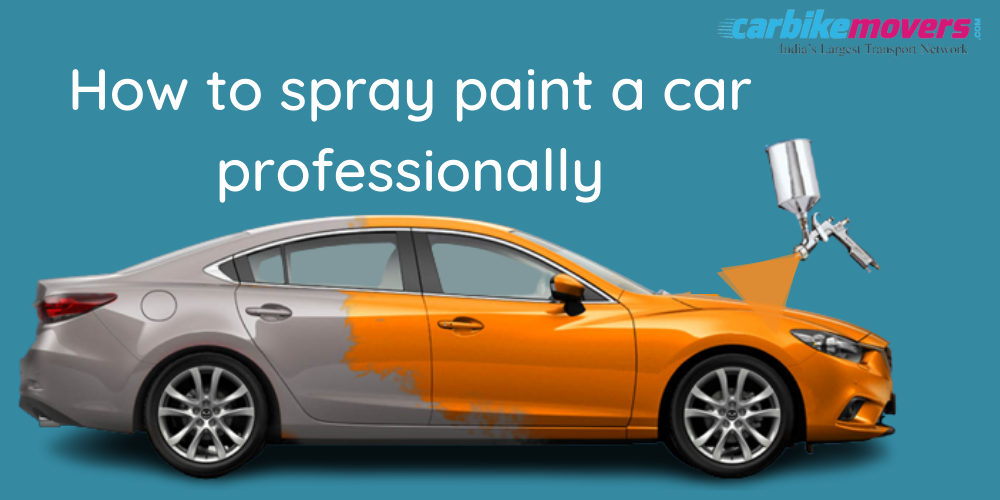How to spray paint a car professionally
If you want to change the colour of your car for the new look then our cost effective ways to give your car new look in an easy manner. Whether you’ve recently used car transport in Delhi or car transport in Bangalore and want to refresh your vehicle’s look after the move, these simple upgrades can make a big difference.
Things required to spray paint a car: In order to properly spray paint your:
- A power sander
- Sanding pads
- An air compressor
- A paint sprayer
- 1200- and 2000-grit sandpaper
- A cleaning solvent
- Newspaper
- Masking Tape
- Primer
- Enamel, acrylic enamel, or polyurethane paint
- Paint thinner
- A face mask
- Safety glasses
- Undercoat/primer
- A clear coat lacquer
- A rag
- Denatured alcohol or mineral spirits
- Rubbing compound (optional)
Steps to spray a paint
Every process requires time and effort. So painting your vehicle requires plenty of time, make sure that you have a few days so that you can set aside your car for a few days to do the job right.
Step 1: Choose Your Location Wisely
Firstly you need to find the perfect location for your car where you will do all the actual painting. So before starting painting you need to find a suitable location for your DIY project. Make sure the place has plenty of room for working around your car, and is well ventilated and well lit. Choose a place which has electricity and has minimal dust. You need to avoid the residential garages, since these often have furnaces or heaters, which pose a fire hazard when coming into contact with paint fumes.
Step 2: Remove rust, dents, and trim
Before starting painting make sure your paint job does not accentuate any imperfections. You need to fix all visible dents, repair any rust, and remove chrome or plastic trim. Mouldings and trim can be replaced after painting is complete.
Step 3: Sand
Always give your paint a smooth and even surface. So you need to sand your entire vehicle using circular motions, either all the way to the bare metal, to the original primer, or at least enough for your new coat of paint to adhere to. If you are short on time, sanding down to bare metal for the best results.
Step 4: Clean
For cleaning the car use the rag and denatured alcohol or mineral spirits, wipe down all surfaces of your vehicle thoroughly, to remove any oil residue and ready it for painting.
Step 5: Tape Surfaces
Always use masking tape and newspaper to cover the surfaces of your vehicle which you don’t want painted, including mirrors, window trim, glass, grills and door handles.
Step 6: Prime
After sanded down your vehicle to the bare metal, now you need to use a corrosion-resistant and self-etching primer in order to prime the surface of your car.
Step 7: Allow primer to cure
Always remove all rust, and also make sure to prime the car properly. Prime the car until you will get a smooth surface and apply enough primer to all the areas. Allow all primers to cure thoroughly, according to instructions on the container.
Step 8: Sand once more
After applying the primer then sand the newly primed surfaces once more, but be sure not to sand too much and expose the metal surface again.
Step 9: Wipe down
Wipe the primed surfaces with a rag slightly dampened with thinner.
After doing all the sanding and primer then you are ready for painting, and make sure you will follow the manufacturer's directions and prepare the paint for spraying.
Step 10: Paint
Always holding your spray gun approximately 6 inches away from your vehicle’s surface, and using a side-to-side sweeping motion, apply paint in thin and even coats. Typically, it will take three to four coats to completely cover the surface. Be sure to follow the manufacturer’s drying time – this can vary from 20 minute to an hour.
Step 11: Sand and Wipe
Before you apply your last coat, sand the surfaces once more to remove powdery residue, then wipe with a clean rag.
Step 12: Apply lacquer
Apply a clear coat lacquer, using the same painting technique.
Step 13: Remove masking tape
Remove masking tape while the clear coat is still wet, then allow the clear coat to dry according to your manufacturer.
Step 14: Buff
Using circular motions, complete your paint job by buffing out all painted surfaces. What’s more, you can use a rubbing compound to bring out a glossy finish.
You might also like:


